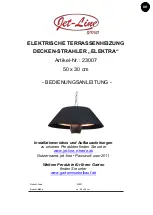
7
ENERCO GROUP, INC. |Indirect Fired Portable Heater
Operating Instructions and Owner’s Manual
1 Main gas pipe
3 Antivibrating coupling
2 Manual shut-off valve
4 Gas valves group
Fig. 3
In case of connection of heater to natural gas, the installation shall
conform with local codes or, in the absence of local codes, with the
National Fuel Gas Code ANSI Z223.1/NFPA 54 and the Natural Gas
and Propane Installation Code, CSAB149.1.
In case of connection to a propane supply cylinder:
(a) the installation must conform with local codes or, in the
absence of local codes, with the Standard for the
Storage and
Handling of Liquified Petroleum Gases, ANSI/NFPA 58
and the
Natural Gas and Propane Installation Code, CSA B149.1.
(b) to determine size and capacity of the cylinder(s) and for any
specific requirements consult your LP gas supplier. In any case
propane tank should not be lower than 100 lb (90 liters)
(c) the cylinder supply system shall be arranged to provide for
vapour withdrawal from the operating cylinder;
(d) the gas shall be turned off at the propane supply cylinder when
the heater is not in use;
(e) when the heater is to be stored indoors, the connection
between the propane supply cylinder and the heater must be
disconnected and the cylinders removed from the heater and
stored in accordance with Standard for the
Storage and
Handling of Liquified Petroleum Gases, ANSI/NFPA 58 and
CSA B149.1, Natural Gas
and
Propane Installation Code
.
The appliance and its individual shut-off valve must be
disconnected from the gas supply piping system during any pressure
testing of that system at test pressures in excess of 1/2 psi (3.5 kPa).
The appliance must be isolated from the gas supply piping system
by closing its individual manual shut-off valve during any pressure
testing of the gas supply piping system at test pressures equal or
less than 1/2 psi (3.5 kPa).
A minimum 1/8” NPT plugged tapping, accessible for test gauge
connection, must be installed immediately upstream of the gas
supply connection to the appliance.
STARTUP
The heater is supplied after a complete functional test and it’s
therefore prearranged for one of the gas (natural or L.P.G.) indicated
in Tab. I: an adhesive label applied on the manual gas selector valve
(Fig. 4) indicates the working gas (usually it’s natural gas). Should it
necessary to change the kind of gas (from natural gas to L.P.G or
viceversa) follow the detailed instructions indicated in section
“CHANGING TYPE OF GAS”.
Only when the heater has been prearranged according to the
proper working gas it will be possible to carry out the following
operations:
•
Leak away some gas from the feed pipe;
•
Check that the pipe is gas proof;
•
Open the gas stopcock and start the hot air generator;
For installation in the U.S.A. at elevation above 2,000 feet (610 m),
the appliance shall be derated 4 per cent for each 1,000 feet (305 m)
of elevation above sea level.
For installation in Canada at elevation above 2,000 feet to 4,500
feet above sea level, the heater is deratedy reducing the input for the
appropriate fuel in accordance with the rating plate manifold
pressure.
THE CONVERSION SHALL BE CARRIED OUT BY A
MANUFACTURER’S AUTHORIZED REPRESENTATIVE,
IN ACCORDANCE WITH THE REQUIREMENTS OF THE
MANUGFACTURER, PROVINCIAL OR TERRITORIAL
AUTHORITIES HAVING JURISDICTION AND IN
ACCORDANCE WITH THE REQUIREMENTS OF THE
CAN/CGA-B149.1 OR CAN/CGAB149.2 INSTALLATION
CODES.
A conversion label shall be applied adiacent to the Rating Label:
THIS APPLIANCE HAS BEEN CONVERTED FOR USE
AT AN ALTITUDE OF ___________ FEET (ABOVE 2000 FEET)
Orifice size:
______________________________________
Manifold pressure:
______________________________________
Input rate:
______________________________________
Date of conversion:
______________________________________
Type of fuel:
______________________________________
Converted by:
______________________________________
For installation in Canada at elevation above 4,500 feet above sea
level, consult Provincial or Territorial Authorities having jurisdiction.
CHANGING TYPE OF GAS
This operation may be carried out several times during the working
life of the machine and not only at initial start-up. Therefore, first of all
check the adhesive label attached to the manual gas selector valve
(a) in Fig. (2) to establish the original category of the gas and then
consult Tab. I to identify the supply pressure, the working pressure,
the use conditions of manual valve.
To change kind of gas it is necessary (Fig. 2):
•
to remove the sticker on the manual gas selector valve stating
the gas used at that time,
•
to remove the screw under the sticker and turn the manual
handle on the correct side according to the condition described in
Tab.I and by following instruction:
Fig. 4
•
After having moved the handle into the opposite position, put
again the fixing screw and a new sticker on it, stating the gas
which has to be used (a number of different stickers are supplied
with the machine)
Burner pressure shall not be adjusted: the heater is
ready to run on the new gas
Should it necessary to check the burner pressure:
•
connect a manometer to the pressure port (b) ,
•
carry out the pressure reading on the manometer and turn the
pressure regulator (c) if necessary to obtain the correct burner
pressure value indicated in Tab. I
OPERATING INSTRUCTIONS
Any time the power cord of the heaters is connected to
a receptacle check the polarity of power supply:
•
check switch (9) and (13) are on “0”
•
connect plug to receptacle
•
push button (14): if it lights up, then reverse polatiry
If the correspondance of phase / neutral polarity is not
correct, the unit may stop in the reset mode.
HEATING MODE
WARNING :
WARNING :
WARNING :
WARNING :








































